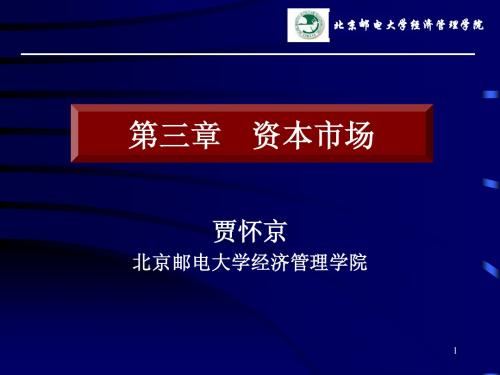第03章 资本市场(讲义)简易版
金融市场学chap3资本市场

(二)认购与销售
➢ 1、包销(Firm Underwriting)是指承销商以低于发行定价 的价格把公司发行的股票全部买进,再转卖给投资者,这样 承销商就承担了在销售过程中股票价格下跌的全部风险。
➢ 2、代销(Best-Effort Underwriting)即“尽力销售”, 指承销商许诺尽可能多地销售股票,但不保证能够完成预定 销售额,任何没有出售的股票可退给发行公司。
账面价值:又称“股票净值”或“每股净资产”,指用 会计方法计算出来的每股股票所代表的实际资产的价值。 等于(公司净资产-优先股权益)/流通的股数,是股 票投资价值分析的重要指标。
清算价值:指股份公司破产或倒闭后进行清算时每一股 份所代表的实际价值。与股票的净值一般不一致。
内在价值:即“理论价值”,也即未来收益的现值。股 票的内在价的复合:参加优 先股和非参加优先股。
③按公司是否有收回优先股的权利:可收回优先股 和不可收回优先股
④按是否可转换为普通股:可转换优先股和不可转 换优先股
2、按上市地点和投资者不同分类
A股:人民币普通股票。是指在中国境内面向中国 公民发行的境内公司股票,允许境内机构、组织、 个人和QFII以人民币认购和交易的普通股股票。
2、交易原则
上市股票的交易一般采取公开竞价法,又称双边 拍卖法,是买卖双方按价格优先和时间优先原则 进行集中竞价。
(1)价格优先原则:价格最高的买方报价和价格最 低的卖方报价优先与其他一切报价而成交。
(2)时间优先原则:在买卖双方报价价格相同时, 在时间序列上,按报价先后顺序依次成交。
连续竞价制度
(2)法人股:指企业法人或具有法人资格的事业 单位和社会团体以其依法可经营的资产向公司非 上市流通股权部分投资所形成的股份。
财会类专业知识金融学3(资本市场)

理论攻坚-金融学3(讲义)第三节资本市场一、股票市场股票市场是指专门对股票进行公开交易的市场。
(一)股票的含义股票是股份有限公司发行的、用以证明投资者的股东身份和权益,并据以获得股息和红利的一种所有权凭证,是金融市场上重要的长期投资工具。
(二)股票的特征收益性、流动性、风险性、参与性、永久性。
(三)股票的分类1.按股票所代表的股东权利划分为普通股和优先股。
(2)我国股票根据上市地点及股票投资者的不同,分为A股、B股、H股、N股等。
A股是以人民币标明面值、以人民币认购和进行交易、供国内投资者买卖的股票。
B股又称为人民币特种股票,是指以人民币标明面值、以外币认购和进行交易、专供外国和我国香港、澳门、台湾地区的投资者买卖的股票。
H股是指由中国境内注册的公司发行、直接在中国香港上市的股票。
N股是指由中国境内注册的公司发行、直接在美国纽约上市的股票。
(四)股票价格1.发行价格(1)溢价发行:发行价格>票面金额①中间价发行:市场价格>发行价格>票面金额②时价发行(2)平价发行:发行价格=票面金额2.理论价格股票价格由预期股息收入和当时的市场利率决定。
即:股票价格=预期股息收入市场利率二、债券市场债券市场是指债券发行和交易的场所。
(一)债券的含义债券是债务人向债权人出具的、在一定时期支付利息和到期归还本金的债权债务凭证。
(二)债券的特征收益性、安全性、偿还性、流动性(三)债券的分类1.按照发行主体,可分为政府债券、公司债券和金融债券。
安全性:政府债券>金融债券>公司债券风险性:公司债券>金融债券>政府债券2.按照债券期限,可分为短期债券、中期债券和长期债券。
3.按照利息支付方式,可分为附息债券、贴现债券(零息债券)4.按照性质不同,可分为信用债券、抵押债券和担保债券。
5.按照能否转换为公司股票,可分为不可转换债券、可转换债券、可交换债券。
(四)债券的发行价格1.溢价发行:发行价格>票面金额;2.平价发行:发行价格=票面金额;3.折价发行:发行价格<票面金额。
资本市场精讲.pptx

证券市场的分类
按照有价证券的运动形态划分:发行市场和流通市场即一级市场和二级 市场;
按资本交易的对象划分:股票市场、债券市场和基金市场。
第6页/共46页
证券市场的基本功能
• (1) 筹资功能
证券市场的筹资功能是指证券市场为资 金需求者筹集自己的功能。这一功能的另一 个作用是为资金供给者提供投资对象。
• 投资者购买首次发行股票的活动——打新股。 • 认购方式:当认购的股数大大超过公司股票的数量时,采用摇
号抽签 ——全额预缴款:全额打款,中号可购买1000股。 ——按市值配售:每一万市值分配一个号码,每个中签号码可以
购买1000股。
第33页/共46页
我国股票发行方式
• 指标审批制 • 核准制 • 保荐人与询价制度
第15页/共46页
• 随时公布市场成交数量、价格等行情信息,便于投资者进行投资决策。 • 是组织和调控证券交易活动的重要机构,它方便地监控证券交易行为,减少价格操纵等违法交易。
第16页/共46页
交易所组织形式 :
• 公司制:由银行、证券公司、信托投资公司等共同投资入股组 建起来的公司法人。公司制的证券交易所对本所内的证券交易 员有担保责任,因此通常设有赔偿基金,或向国库交纳营业保 证金,以赔偿因该所成员违约而遭受损失的投资者。公司制的 证券交易所通常规定,证券商及其股东或经理人不得担任证券 交易所的董事、监事或经理,以保证证券交易所经营者与交易 参与者的分离。
第44页/共46页
Thank you for listening
第45页/共46页
感谢您的观看!
第46页/共46页
资本市场在金融体系中的位置
金融市场
间接金融市场
第三章 资本市场教学课件

贴现收益率:
rDY
1000 P 360 1000 n
等价收益率:
1000 P 365
rEY
p
n
有rEA效R 收1益率10:00p
P
365
n
1
第二节 债券市场
三、公司债券
(一)公司债券的定义
公司债券是公司依照法定程序发行、 约定在一定期限内还本付息的有价证券。
一
资本市场概念
二
资本市场功能
2019/12/4
三 我国多层次的资本市场
第一节 资本市场概述
一、资本市场概念
资本市场是期限在一年以上各种资金借贷和证券交易 的场所。
第一节 资本市场概述
二、资本市场功能
融资功能
配置功能
资本市 场功能
产权功能
第一节 资本市场概述
三、我国多层次的资本市场
交
易 全所 国市
案例思考 面对暴涨与急跌,我们会问,股票价格的合理区间究竟是如何确定的?在 一片追涨杀跌声中,我们会想,为什么我们的行为是如此的?我们能不能规避 这种疯狂?我们希望下面的内容能够帮助大家对资本市场有进一步的认识。
本章内容
第三章 资本市场
第一节 资本市场概述
第二节 债券市场
第三节 股票市场
第一节 资本市场概述
流动性
第二节 债券市场
(四)债券的种类
发行主体
担保方式
1
政府债券 金融债券 企业债券
2
信用债券 保证债券 抵押债券 质押债券
支付利息
3
零息债券 附息债券 息票累积债券
选择权
4
赎回债券 可转换债券 偿还基金债券 附认股权证债券
第三章资本市场ppt课件

4、发行定价
平价 溢价 折价
三次定价过程: a投资银行报价,选择报价较高银行 b编制招股说明书,确定合理价格区域 c发行公司与投资银行商讨定价
精选课件ppt
(二)认购与销售 1、包销 承销商以低于发行价的方式把公司发行的股票全 部买进,再转卖给投资者。利润来自于承销折扣
精选课件ppt
信用交易又称为保证金购买,是指对市场行情看 涨的投资者交付一定比例的初始保证金由经纪人 垫付其余价款,为他买进指定证券。
保证金比 保例 股 证票 金市 账值 户净值
例:假设A股票每股市价为10元,某投资者对该股票 看涨,于是进行保证金购买。该股票不支付现金红 利。假设初始保证金比率为50%,维持保证金比率 为30%。其自有资金为10000元。 1、股价升到14元,投资收益率为? 2、用50%保证金比例购买,投资收益率为? 3、用20%保证金比例购买,投资收益率为? 4、股价跌至7.5元,保证金比例为? 5、股价跌至5元,保证金比例为? 6、股价下跌至?元,收到保证金通知
精选课件ppt
(3)证券交易委托种类 证券交易委托是指投资者通知经纪人进行证券买
卖的指令 市价委托 限价委托 停止损失委托 停止损失限价委托
精选课件ppt
精选课件ppt
精选课件ppt
精选课件ppt
精选课件ppt
a市价委托: 委托人自己不确定价格,而委托经纪人按市面上 最有利的价格买卖证券。 b限价委托: 是指投资者委托经纪人按他规定的价格或者比限 定价格更有利的价格买卖证券
精选课件ppt
精选课件ppt
H股,是指在境内注册,在香港上市的股票 S股,是指在中国内地注册的公司,在新加坡上
市股票 N股,是指那些在中国大陆注册、在纽约上市的
《资本市场》课件

• 资本市场概述 • 股票市场 • 债券市场 • 期货市场 • 外汇市场
01
资本市场概述
资本市场的定义
资本市场定义
资本市场是金融市场的一部分,主要涉及长期资金的借贷和投资。它涵盖了债券 、股票、衍生品等金融工具的交易和运作。
资本市场与商品市场、货币市场的区别
与商品市场和货币市场相比,资本市场涉及的交易工具和资金期限更为复杂和多 样化。
逐日盯市制度
02
期货交易实行逐日盯市制度,即每个交易日结束后,对持仓合
约进行盈亏结算,以控制风险。
涨跌停板制度
03
期货交易实行涨跌停板制度,即限制每日价格波动幅度,以控
制风险。
期货的风险管理
风险识别
通过市场分析、基本面分析等技术手段,识别和评估市场风险。
风险控制
通过建立止损、仓位控制等手段,控制风险。
股票的价格与波动
总结词:股票的价格由市场供求关系决定,受到多种 因素的影响,如公司业绩、市场情绪、宏观经济等。
详细描述:股票的价格由市场供求关系决定,受到多种 因素的影响。公司业绩是影响股票价格的重要因素之一 ,如果公司业绩好,投资者对公司的未来发展前景看好 ,就会增加对该公司的投资,从而推高股价。市场情绪 也会影响股票价格,当市场情绪高涨时,投资者对市场 的信心增强,会加大投资力度,从而推高股价;反之, 当市场情绪低迷时,投资者信心不足,会减少投资,导 致股价下跌。宏观经济因素也会影响股票价格,如经济 增长率、通货膨胀率、利率等。
经济数据
各国的经济数据,如GDP 、通胀率、贸易数据等, 也会对外汇汇率产生影响 。
外汇市场的交易方式与风险
交易方式
外汇市场的主要交易方式包括即期交易、远期交易、掉期交易和期权交易等。
资本市场介绍PPT课件

11
LOGO
.
各地证券市场介绍
4、公司必须在最近3个财政年度里连续盈利, 且在最后一年不少于250万美元、前两年每年 不少于200万美元,或最后一年不少于450万 美元,3年累计不少于650万美元; 5、公司的有形资产净值不少于1亿美元; 6、对公司的管理和操作方面的多项要求; 7、其他有关因素,如公司所属行业的相对稳 定性,公司在该行业中的地位,公司产品的市 场情况,公司的前景,公众对公司股票的兴趣 等。
9
LOGO
.
各地证券市场介绍
纽约证交所对美国国内公司上市的条件要求
1、公司最近一年的税前盈利不少于250万美元; 2、社会公众拥有该公司的股票不少于110万股; 3、公司至少有2000名投资者,每个投资者拥有
100股以上的股票; 4、普通股的发行额按市场价格计算(市值)不少
于4000 万美元; 5、公司的有形资产净值不少于4000万美元。
证券交易市场——已发行的证券进行买卖、 转让、流通的市场,也称二级市场。
交易形式包括证券交易所交易、场外交易。
5
LOGO
.
什么是证券市场?
股票是股份公司在筹集资本时向出资人(投资人 )发行的、用以证明其股东身份和权利的所有权 凭证。股票持有人成为股份公司的股东。
债券是政府、金融机构、工商企业等直接向社会 筹措资金时,向投资者发行,承诺按到期支付本 息的债权债务凭证。债券购买者与发行者之间是 一种债权债务关系,债券发行人即债务人,投资 者(债券持有人)即债权人。
3第三章 资本市场

12
(二)、股票的种类 )、股票的种类
2、优先股(Preferred Stock) 优先股( ) 优先股按其所享有的权限可以划分为: (1)累积优先股和非累积优先股 (2)参加优先股和非参加优先股 (3)可转让优先股( Convertible Preferred Stock) (4)可赎回优先股(Callable Preferred Stock):
11
(二)、股票的种类 )、股票的种类
Stock) 2、优先股(Preferred Stock) 优先股( 优先股的优先性表现在分得固定股息并且在普通股 之前收取股息。 优先股通常没有投票权,只是在某些特殊情况下才 具有临时投票权。一般为公司的政策变化或效益不佳等影 响到优先股的股息支付时,优先股才有投票权。如,当公 司财务困难而无法在规定的时间内支付优先股股息时,优 先股就具有投 优先股的股息是固定的,其价格与公司的经营状况 关系不如普通书 在招股说明书的准备过程中,一般组建专家工作团并 有较明确的分工: 发行公司的管理层在其律师的协助下负责招股说明书的非 财务部分。 发行公司的会计师准备所有的财务数据。 作为承销商的投资银行负责股票承销合约部分。 独立的注册会计师对财务帐目的适应性提供咨询与审计。
第一节 股票市场 第二节 债券市场 第三节 投资基金
3
第一节 股票市场
一、股票的概念、性质与种类 股票的概念、 二、股票的一级市场 三、股票的二级市场 四、我国的股票市场
资本市场 ppt

Stock trading on credit
讨论问题3: 为什么在金融市场发达 的市场经济国家,会有 股票的信用交易? 其功能和目的是什么?
资料卡: 我国有关信用交易 (融资融券)相关新闻
据了解,由于《证券公司融资融券业务试 点管理办法》和《证券公司融资融券业务 试点内部控制指引》于2006年 8月1日起 正式实施,证监会为贯彻落实《办法》的 有关规定,审慎做好券商融资融券业务试 点申请审核工作,上周末向北京、上海、 江苏、安徽、广东、深圳、湖北等地证监 局发出通知,明确了券商申请开展融资融 券业务的一些相关问题。
简单算术股价指数
相对法
综合法
1 n
p pΒιβλιοθήκη i 1 i 0 i 1 i 1 n
n
p p
i 1 i o
加权股价指数
拉斯拜尔指数 (以基期成交股数为权 数)
派许指数 (以报告期成交股数为 权数)
PQ PQ
I 0
0 0
PQ PQ
1 0
1 1
德国法兰克福股指
世界上大多数股指
融资额:206.9亿港币 发行股数:24.2亿股 收市报价:10.68港元,较招股价每股 8.55港元上升约24.91%。
认购人数:54万!
STOCK MARKET
股票二级市场 二级市场通常分为有组织的证券交易所和 场外交易市场。 也出现了具有混合特征的第三市场和第四 市场。
STOCK MARKET
假设该股票跌到12元,你就可以按此价格买回股 票还给经纪人,每股赚6元,共赚6000元.投资收益 率为66.67%.
资本市场 (2)-PPT精选文档120页

Capital Market
本章内容
第一节 资本市场 第二节 股票市场** 第三节 基金市场 第四节 中国资本市场回顾与展望
第一节 Capital Market
Capital Market
一、定义 资本市场是指融资工
具期限超过一年的长 期融资市场。资本市 场的融资工具主要包 括股票、债券和基金 等。
融券案例
2019年3月30日 《重庆日报》发表文章,题目:
《半小时内抓住百万发财机会, 融券者5万股做空双汇!》
融券案例
1、事件起因 3月15日9:30分,双汇发展(000895)开盘
后一度翻红,走势稳健。 10:30分,央视播出“瘦肉精”事件。 之后半个小时左右的时间,市场也似乎被
打蒙了一样,并没有马上反应过来。 11:00,一些回过味来的投资者才开始陆
续抛出手中股票。午后一点开盘后,双汇 终于承受不住越来越凶猛的抛压,跌停。
融券案例
融券案例
2、融券操作 双汇发展是90只融资融券标的之一,但是
以前其无论是融资还是融券,交易都不活 跃。 而3月15日,即央视播出“瘦肉精”事件 的当天,却突然出现5.31万股的融券卖出 和500股的融券偿还。收盘时双汇发展的 融券余量为5.3万股,市值约413万元。
讨论问题2: 为何规定股价上升才能卖空?
Selling on credit
案例 假设你有9000元现金,并对B股看跌.该股票不支
付红利,目前市场价格为每股18元.初始保证金比 例为50%,维持保证金比例为30%. 这样你就可以向经纪人借入1000股卖掉.
假设该股票跌到12元,你就可以按此价格买回股 票还给经纪人,每股赚6元,共赚6000元.投资收益 率为66.67%.
第03章资本市场

Order)。
2020/4/28
14
信用交易
信用交易又称垫头交易或保证金交易,是指证券买
者或卖者通过交付一定数额的保证金,得到证券经 纪人的信用而进行的证券买卖。信用交易可以分为 信用买进交易和信用卖出交易。
2020/4/28
25
1.简单算术股价指数
❖ (2)综合法。综合法是先将样本股票的基期
和报告期价格分别加总,然后相比求出股价
指数,即:
股价指数
n
P1i
i1 n P0i i 1
2020/4/28
26
2.加权股价指数
❖ 加权股价指数是根据各期样本股票的相对重要
性予以加权,其权重可以是成交股数、总股本
3.备用包销 。
2020/4/28
7
三、股票的二级市场
❖ 二级市场(Secondary Market)也称交 易市场,是投资者之间买卖已发行股票 的场所。这一市场为股票创造流动性, 即能够迅速脱手换取现值。
❖ 二级市场通常可分为有组织的证券交易 所和场外交易市场,但也出现了具有混 合特型的第三市场(The Third Market) 和第四市场(The Fourth Market)。
2020/4/28
8
一、证券交易所
证券交易所(Stock Exchange)是由证 券管理部门批准的,为证券的集中交易 提供固定场所和有关设施,并制定各项 规则以形成公正合理的价格和有条不紊 的秩序的正式组织。
世界各国证券交易所的组织形式大致可 分为两类:
- 1、下载文档前请自行甄别文档内容的完整性,平台不提供额外的编辑、内容补充、找答案等附加服务。
- 2、"仅部分预览"的文档,不可在线预览部分如存在完整性等问题,可反馈申请退款(可完整预览的文档不适用该条件!)。
- 3、如文档侵犯您的权益,请联系客服反馈,我们会尽快为您处理(人工客服工作时间:9:00-18:30)。
Section 3.1 Text⏹Purpose and ParticipantsFirms that issue capital market securities and the investors who buy them have very different motivations than they have when they operate in the money market. Firms and individuals use the money market primarily to warehouse funds for short periods of time until a more important need or a more productive use for the funds arises. By contrast, firms and individuals use the capital market for long-term investments. The capital markets provide an alternative to investment in asset such as real estate or gold. Meanwhile, the primary reason that individuals and firms choose to borrow long-term funds is to reduce the risk that interest rates will rise before they pay off their debt. This reduction in risk comes at a cost. However, most long-term interest rates are higher than short-term rates due to risk premiums. Despite the need to pay higher interest rates to borrow in the capital markets, these markets remain very active.The primary issuers of capital market securities are governments and corporations. However, governments never issue stocks.Corporations both issue bonds and stocks. One of the most difficult decisions a firm faces can be whether it should finance its growth with debt or equity. The distribution of a firm’s capital between debt and equity is its capital structure.⏹Trading in the Capital MarketCapital market trading occurs in either the primary market or the secondary market. Investment funds, corporations, and individual investors can all purchase securities offered in the primary market, where new issues of stocks and bonds are introduced. When firms sell securities for the first time, the issue is an initial public offering.The capital markets have well-developed secondary market. A secondary market is where the sale of previously issued securities takes place, and it is important because most investors plan to sell long-term bonds before they reach maturity and eventually to sell their holdings of stocks as well.1. BondsThe capital markets are where securities with original maturities of greater than one year trade. Capital market securities fall into three categories: bonds, stocks, and mortgages. In this section, we focus on bonds.Bonds are securities that represent a debt owed by the issuer to the investor. Bonds obligate the issuer to pay a specified amount at a given date.Treasury BondsThe government issues notes and bonds to finance the national debt. The difference between notes and bonds is that notes have an original maturity of 1 to 10 years while bonds have an original maturity of 10 to 30 years. (Recall from last chapter that Treasury bills mature in less than 1 year.)Government notes and bonds are free of default risk because the government can always print money to pay off debt if necessary.Corporate BondsWhen large corporations need to borrow funds for long periods of time, they may issue bonds. The bond indenture is a contract that states the lender’s rights and privileges and the borrower’s obligations. Any collateral offered as security to the bondholders will also be described in the indenture.The degree of risk varies widely among issues because the risk of default depends on the company’s health, which can be affected by a number of variables. The interest rate on corporate bonds varies with the level of risk. Bonds issued by a company with high credit rating has lower interest rates than those with poor ratings.2. StocksShares of stock in the firm represent ownership. A stockholder owns a percentage interest in a firm consistent with the percentage of outstanding stock held. The ownership is in contrast to a bondholder, who holds no ownership interest but is rather a creditor of the firm.Ownership of stocks gives the stockholder certain rights regarding the firm. One is the right of a residual claimant: Stockholders have a claim on all assets and income left over after all other claimants have been satisfied. If nothing is left over, they get nothing. As noted, however, it is possible to get rich as a stockholder if the firm does well.Investors can earn a return from stocks in one of two years. Either the price of the stock rises over time, or the firm pays the stockholder dividends. Frequently, investors earn a return from both sources. Stocks are more risky than bonds because stockholders have a lower priority than bondholders when the firm is in trouble. The returns to investors are less assured because dividends can be easily changed, and stock price increases are not guaranteed. Despite these risks, it is possible to make a great deal of money by investing in stocks, whereas it is very unlikely by investing in bonds. Another distinction between stocks and bonds is that stocks do not mature.Section 3.2 Specialized TermsAsset n.liquid(current、floating、working、circulating)assetsnon-performing assetnon-performing loaninvisible assets / intangible assetsassets management companyasset restructuring / assets reorganizationassets evaluation / assets appraisal / property assessment / capital ratingratio of liabilities to assets / asset-liability ratioFixed assets refer to assets bought by a company for its continued use for a number of years, rather than for resale. There are three categories of fixed assets: 1) tangible assets, such as land and equipment, 2) intangible assets, such as a company's logo or brand, 3) investments, such as stakes in joint ventures.Premium n.A premium of 2 per cent is paid on long-term investments.Your first premium is now due.Specific regulations governing the issue of share certificates at a premium are separately issued by the State Council.Obligate v.Bonds obligate the issuer to pay a specified amount at a given date.The regulation obligates listed companies to release information about their operations. Rating n.The United States held S&P's top rating for seventy years and never had a downgrade. However, last Friday one of the three major credit rating agencies — S&P, downgraded long-term United States government debt. S&P lowered its opinion of Treasury securities one step from the highest rating, triple-A, to AA-plus.The goal is to improve the country's credit rating so as to ease the concerns of investors and reduce borrowing costs.Stock n.preferred stock common stockStock holder = share holder Stock exchange = stock markettrash stock state-owned stockSpecial treatment stock performance stockblue chip red chip controlling shareholder / majority shareholder Corporations can sell stock as a way to raise money. Stock represents shares of ownership in a company. Investors who buy stock can trade their shares or keep them as long as the company is in business.Dividend n.A company might use some of its earnings to pay dividends as a reward to shareholders. Or the company might reinvest the money back into the business.For a growing company, it will have to keep most of its profit to buy more plants and equipment and thus its dividend payout ratio will be lowPrincipal n. adj.repay principal and interestPrincipal-Agent relationshipIn financial services, the principal mechanism of risk control is self-regulation by the sector.Outstanding adj.outstanding billoutstanding debt outstanding loan outstanding issueoutstanding balanceThe outstanding bill must be paid next week.The Bank or credit-card company settles the client's Bills, invoicing him monthly and charging interest on any outstanding debts.IPO= Initial Public OfferingsInitial public offering is a type of offering where the company sells its stock to the public in the securities market, to raise funds and to be listed.Seasoned equity offering is a type of offering where publicly traded companies issue new shares of stock because the capital raised from the previous offering did not meet the companies needs. Types of SEO include share allotment, public equity offerings,convertible corporate bonds offerings and private equity offerings.Bailout n.Bailout loan: Loan made to borrower whose ability to service outstanding indebtedness has become doubtful.Buyout n.The buyout negotiation lasted several days.The more profitable the company is, the easier to raise funds for the buyout.List v.We encouraged eligible large state-owned enterprises to get listed after the stockholding system was established.Withdrawal of state-owned stock helps optimize share-holding structure of listed company. Prior to the submission of IPO programs, the company had the intention to backdoor listing. Disclosure n.The CSRC required securities companies to provide risk disclosure statements.State proposed regulations to standardize the information disclosure.Unless assets are publicly disclosed, corruption is still going to be an issue. Derivative adj. n.Financial DerivativesDerivative SecuritiesFinancial derivative instruments Convertible bond is a hybrid derivative security that has characters of both stock and bond.Merge v.We have decided to merge these small firms into one large company.Please merge all these items together under the item of "incidental expenses".Merge and acquisition (M&A) is an important and effective way for enterprises to expand. Mergers and AcquisitionsAcquisition n.share acquisitionIts competitors have already begun the acquisition and integration work.Upon completion of this acquisition, the company will become the controlling shareholder.Section 3.3 Subject TopicThe Future Financial Centers of ChinaA: As we all know, both Hong Kong and Shanghai are going to be China’s future financial centers. But I think they have their respective characteristics. Do you think so? B: Yes. Hong Kong is a free port and one of the world’s most important markets for gold, foreign exchange and capital everyday. Capital from all over the world flows in and out freely. It has a highly advanced communication network. At the same time, It possesses a management advantage with advanced service industries and numerous qualified personnel. It also has a favorable market environment. However, Hong Kong has its difficulties, such as narrow space, high service cost and more challenges from new financial centers such as Singapore and Taiwan. However, as a financial center witha free capitalist system, Hong Kong would forever be a joint point of Sino-Europeancivilization. It is a bridge that links China with the rest of the world.A: That is true. Compared with Hong Kong, Shanghai also enjoys a great deal of advantages, like wider space and lower service cost. The production capacity of Shanghai is immense.If Shanghai fully exerts its production capacity, it would become incomparable in the future. Since Shanghai has a large population and is the economic center of the Yangtze Valley, its market is extensive. Moreover, in recent years, its investment environment has become more and more favorable. Therefore, a large number of multinational companies and foreign-funded institutions have been attracted to establish their branches there.There foreign investments have stimulated the economic development of Shanghai. In addition, Pudong has opened up and become the financial core of Shanghai.B: What you have said is right, but I think if Shanghai wants to become one of the top financial centers in Asia, it should further improve itself. First of all, it should maintain a sound socialist market-oriented economy with a complete legal system in thefinancial field as the basis. Secondly, it should form a highly advanced financial market system. The system should include an open market for foreign exchange, gold and capital.Next, it should attract more qualified personnel. They should be equipped with comprehensive knowledge in management, finance, trade and foreign languages. Its service industry and infrastructure construction should also be improved. Finally, Shanghai should fully exert its potential to become a highly developed financial center. A: I quite agree with you. Nowadays, with the opening up of China’s financial field, foreign-funded banks and domestic banks will become intense. Is this beneficial to China’s financial industry?B: Yes, the intense competition could in some way benefit China’s financial development.It will stimulate domestic banks to improve their management, operation and services.At the same time, foreign-funded banks in China will bring us advanced knowledge, experience and practice in management. Moreover, the intense competition will help to create a favorable investment environment in China. More opportunities would be provided for domestic banks to engage in international operations. Finally, it will promote fair competition in China’s economic field as well. However, the intense competition will also influence China’s financial environment. For one thing, compared with domestic banks, foreign-funded banks possess advantages in management, technology, service and qualified personnel. The competition will inevitably make domestic banks lose part of their traditional business to foreign-funded banks. The competition will also probably bring difficulties to the central bank’s financial supervision. Since foreign-funded bank s’ operation observes international practice, it differs from that of domestic banks. Therefore, it challenges the efficiency of the central bank’s supervision.Section 3.4 Questions and Answers1. What are the intermediate objectives of monetary policies?— a. Growth in money supplyb. Interest rate levelc. Growth in the volume of creditd. The exchange rate.2. Please point out the full name of SWIFT and its headquarter.— Society for World Inter-bank Financial Telecommunications. Brussels, Belgian.3. What is the biggest difference between off-balance sheet activities and intermediaryactivities of commercial banks?— Off-balance sheet activities constitute potential assets or liabilities and bear certain risk while intermediary activities don’t constitute risks in assets or liabilities.4. What is the main body of offshore financial market?— It is non-residents.。
